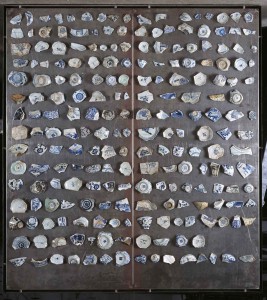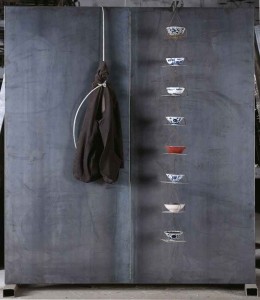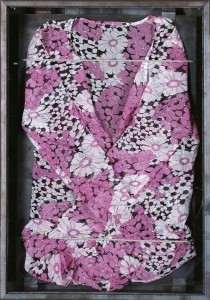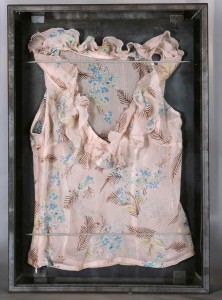Mi è piaciuto molto questo brano dell’intervista di Stefano Malatesta a Janis Kounellis pubblicata domenica su Repubblica. Parla della genesi della mostra dell’anno scorso a Pechino. L’idea delle porcellane. E dei vestiti da bambina. Mi sembrano due idee forti. E molto collegate tra loro.
«E, come spesso mi è successo, all’ inizio non avevo la più pallida idea di quello che avrei fatto. L’ idea buona o il colpo di genio, insomma quello che fa distinguere immediatamente la cazzata dall’ opera riuscita, due momenti diversi ma estremamente vicini tra loro, tardava a venire». Kounellis, un carattere di solito molto controllato, ha cominciato ad agitarsi. Il suo desiderio di piacere, la sua determinazione a raggiungere il successo sono sempre stati molto grandi e un eventuale flop della mostra lo avrebbe portato alla depressione. «Poi, un giorno, in un mercato all’ aperto di Pechino ho notato piramidi di porcellane frantumate. Ce n’erano di bellissime, molto antiche. Con quella meravigliosa trasparenza così difficile da raggiungere. Io non riuscivo a capire le ragioni di tutti quei pezzi e a che cosa servissero. Poi un artista mio amico mi ha raccontato che durante il periodo maoista, al tempo della famigerata Banda dei Quattro, le guardie rosse entravano nelle case delle persone considerate borghesi e se trovavano delle porcellane le gettavano in terra finendole di fare a pezzi con i calci dei fucili in quanto simboli detestati della Cina dei Mandarini». Il giorno dopo Kounellis è andato al mercato e ha comprato tutte le porcellane su cui riusciva a mettere le mani, pagandole una cifra irrisoria. Poi le ha divise per forma, dimensione e colore e le ha attaccate una dietro l’ altra, come farebbe un collezionista di francobolli o di farfalle con estrema precisione, su lastre di ferro grandi quanto un letto a due piazze e pesanti quattrocento chili ciascuna. Infine ha allineato le lastre fino a formare una muraglia, la cui pianta disegna una greca sormontata da pezzi di carbone. Quando l’ artista nella sua casa di Roma ha tirato fuori le fotografie che riprendevano dall’ alto l’ installazione ho trattenuto per un attimo il respiro. Raramente avevo visto una simile, sorprendente fusione di due materiali così eterogenei come il ferro e la porcellana. Dopo pochi giorni da questa installazione ne ha fatto un’ altra per lui rivoluzionaria: «Nel passato ho sempre cercato di evitare i colori. Li ritenevo futili e controproducenti rispetto alla mia concezione dell’ arte come teatro dei drammi». Ma nei giorni in cui si trovava a Pechino è andato in giro a comprare vestiti da bambina coloratissimi che ha disteso sulle lastre. Un gesto di riconciliazione con il mondo dei colori che ha lasciato stupefatto Marino, abituato ai toni cupi senza speranza delle sue opere. L’accoglienza della mostra è stata spettacolare: «Credo che quello che ha attirato i visitatori siano state proprio le schegge, il modo con cui un artista occidentale ha valorizzato l’ importanza del prodotto più famoso della Cina. Per secoli gli europei hanno cercato di imitare, senza riuscirci, l’ impasto tenuto segreto che permetteva quei meravigliosi manufatti e ora arrivava in Cina un artista straniero che non tentava di copiare, ma che con le sue opere rendeva omaggio alle porcellane, anche se maltrattate dagli stessi cinesi».
 |
 |
 |
 |
I really enjoyed this part of the interview with Janis Kounellis published by Stefano Malatesta on Sunday. It speaks of the genesis of the exhibition in Beijing made last year. The idea of porcelain. And the baby-girl clothes. I seem to be two strong ideas. And much linked together.
«And, as often happened to me, at the beginning I had no idea of what I would do. The good idea or a brainwave, in short, what does distinguish immediately a cock-up by successful work, two different moments but extremely close to each other, was late in coming». Kounellis, a character usually very controlled, began to fidget. His desire to please, his determination to succeed have always been very large and an eventual flop of the show would have led to depression. «Then, one day, in a market in Beijing I noticed pyramids of broken porcelain. There were beautiful, very old. With that wonderful transparency so hard to achieve. I could not understand why all those pieces and what they were. Then an artist friend of mine told me that during the Maoist period, at the time of the notorious Gang of Four, the Red Guards entered the homes of people considered middle class and if they found the casting of porcelain clay they shred with the butts of rifles as hated symbols of the Mandarins of China». The next day Kounellis went to the market and bought all the porcelain on which he could lay my hands, paying them a pittance. Then he divided the shape, size and color and has attached one behind the other, as would a collector of stamps or butterflies with extreme precision, of iron plates as big as a double bed and heavy four hundred pounds each. Finally the plates lined up to form a wall, which draws a Greek plant topped with pieces of coal. When the artist in his home in Rome has pulled out from the photographs that reflected the top installation, I held my breath for a moment. I had rarely seen such a surprising merger of two heterogeneous materials such as iron and porcelain. After a few days of this installation made it a revolutionary one for him: «In the past I always tried to avoid the colors. I felt futile and counterproductive to my conception of art as a theater of drama». But in the days when he was in Beijing has gone out to buy colorful girl clothes who spread out on plates. A gesture of reconciliation with the world of colors that left Marino stunned, accustomed to the dark tones with no hope of his works.
 |
 |
 |
 |